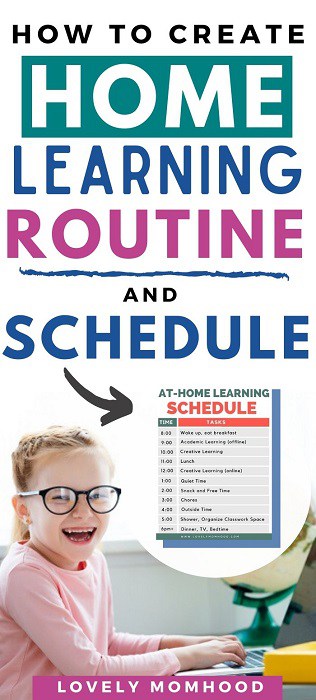How to Create an At-Home Learning Routine with Printable Schedule
At-home learning can be quite the undertaking, especially for moms who don’t normally do it. Whether you want to set up a structured summer learning schedule, add supplemental learning to what the kids are learning in school, teach while traveling, or because of a recent world pandemic, here are some crucial elements to creating an at-home learning routine and schedule.
It is important to add that although this article contains homeschooling principles, it is not about homeschooling, per se.
While homeschooling (in the U.S.) involves an approved and structured curriculum, home-learning is simply a parent’s effort to help kids learn and reinforce school principles taught primarily in a traditional school setting.
It also works great for special circumstances like summer learning, while traveling, or for any other reason that would require kids to stay indoors for an extended period.
It is also a great resource for moms looking to teach younger kids who have yet to start school.
Looking to create an at-home learning routine but don’t know where to start? Here’s how…
How to Create an At-Home Learning Routine and Schedule

1. Identify the reasons for at-home learning
Before you can begin your at-home learning routine it is important to identify the reason for teaching at home.
Circumstances will often dictate the course of the home learning curriculum, schedule, and resources needed.
What do I mean by circumstances, consider the following:
Supplemental Leaning: If you are considering supplemental home learning (learning in addition to school learning such as tutoring), then your learning from schedule will likely be in the afternoons and weekends.
Summer Learning: Many parents opt for home learning as part of their kid’d summer break. If you are choosing to “summer school” your teaching schedule might consist of a more laid back and flexible approach.
World Pandemic: As recently experienced with the Covid-19 virus, many schools suspended classes and millions of parents had no choice than to teach from home. Luckily, as least here in the U.S, most students continued their school lessons by following a virtual curriculum. If that is the case, then the school’s virtual curriculum will play a big role in the home learning schedule.
So, that is why it is so important to identify the reason for homeschooling. That is because depending on your particular circumstance it might impact your leaning schedule.
2. Identify your involvement

Another thing to consider while creating a home learning routine is your involvement.
The reason for this is because you will have to create an at-home learning schedule that allows your child to work dependably (with you), independently (without you), or both.
For instance, if we use the At-Home Summer Learning scenario as an example, your child might not have access to your help if you work outside of the home. If the kids will be spending their summer days at grandma and grandpa’s it is important you craft an at-home learning schedule that allows for a bit more independent learning.
The same applies to other examples, such as working from home and at-home learning related to the Corona Virus. If you must work from home, and they must do online schooling simultaneously, ensure you craft a schedule for both you and them that allows you both to work dependently and independently.
3. Consider you child’s age
Not all children have the same attention span or interest level. Taking your child’s age into consideration when crafting an at-home learning schedule and routine will be crucial for a successful experience.
Ensure to include plenty of breaks and hands-on activities (offline) to the younger kids. For older kids it is also important they are given the opportunity to change scenery, stretch, and alternate between a computer screen and other learning methods (if possible).
Therefore, age is definitely something to consider when creating an at-hone learning routine for kids.
4. Pinpoint your start time
One of the primary steps in creating an at-home learning schedule is to set a start time. It is very easy to get caught up in a more relaxed schedule when learning from home than it is to be in a more structured environment like school.
Although some home learning circumstances call for a more laid back approach like summer learning or supplemental learning, other at-home learning circumstances require a more structured setting.
So, pick a start time and be consistent!
5. Set a Schedule
The most important factor in creating an at-home learning routine is to create a schedule the kids can follow.
As previously mentioned, there are many factors that might play a role when opting to create an effective schedule, and that might include:
- the reason for at-home learning
- the start time
- child’s age
- your own schedule
- your involvement
- mandatory assignments by the school
- electronic devices availability if creating a schedule for multiple children
- other factors such as tutors, virtual teachers and classes, etc.
Here is a sample at-home learning schedule that can work really well for multiple circumstances. Feel free to move things around as they fit for your family needs.
I have included FREE printable copies of this at-home learning schedule as well as a blank copy you can print out and make your own.
- 8:00- Wake up, Eat breakfast
- 9:00- Academic Learning (offline)
- 10:00- Creative Learning
- 11:00- Lunch
- 12:00- Creative Learning (online)
- 1:00- Quiet Time
- 2:00- Snack and Free Time
- 3:00- Chores
- 4:00- Outside Time
- 5:00- Shower, Organize Classwork Space
- 6pm+ Dinner, TV, Bedtime
At-Home Learning Printable Schedule
For ideas on at-home learning activities for each of the categories mentioned in this schedule, read on.
6. Learning material variety
Something else to take into considerations when creating a at-home learning schedule is knowing what at activities to include for each category.
Here are some ideas:
At-home offline learning activities
- Workbooks
- Worksheets
- Book reading
- Book reports
- Math work
At-home online learning activities
- Computer programs
- Online school curriculum
- Home learning websites
Creative Activities
- STEM projects
- Science projects
- Arts and Crafts
- Dance
- Kids Exercise
Here is a full list of fun indoor activities for kids of all ages.
Quiet time activities
- Puzzles
- Books
- Coloring
- Painting
- Arts and Crafts
- Legos
Chores
It is important that although kids are continuing their studies at home, they are also assigned chores that help contribute to the family nucleus.
Therefore, consider including age-appropriate chores for kids in you at-home learning schedule. Here are also specific chores for 8-10 year olds you can choose from.
Outside Time
Whether in the front yard or backyard, there are many outdoor actives the kid’s can benefit from. Taking a break from learning and getting some fresh air breaks the cycle and allows for distraction and recharge.
- Ride a bike
- Chalk Art
- Go for a walk
- Hopscotch
- Free play
- Basketball or Soccer
7. At-home online learning resources

There are many great online learning resources that can aid in home learning. In fact, some online websites even offer full curriculum based on state testing and standards (such as IXL.com).
All of the following are great at-home learning resources and they are all currently offering free-trials you can take advantage of.
- ABC Mouse (ages 2-8, currently first month FREE and 60% OFF yearly subscription)
- Adventure Academy (ages 8-13, first month FREE, also from the makers of ABC Mouse)
- Reading IQ (ages 2-12, first month FREE)
- IXL (K-12 Curriculum, FREE 7-day trial, includes math, language arts, science, and social studies)
8. Create an ideal at-home learning space
Another important aspect of creating an at-home learning routine and schedule is having a designated learning space.
Order and organization provides children with a sense of control and consistency which combats anxiety and frustration.
Knowing ahead of time where they will do their home learning and when eliminates overwhelm and negative anticipation towards doing the tasks at hand.
In addition, optimal at-home learning spaces are those that allow children to have good posture and that have great natural lighting.
Consider the following tips for creating an optimal at-home learning space…
Natural lighting and good temperature
Find and area in your home with natural lighting, such as close to a window or glass door. Also, opt for an area of your home where there is a comfortable room temperature as heat and cold can offset concentration efforts.
Set up a study desk
Providing your child with a desk or table that meets their needs can be helpful. The Guidecraft Children’s Media Desk and Chair Set. This desk and chair set keeps up with your fast-growing kids and satisfies elementary and middle-school-aged children.
All supplies at hand
They won’t be doing much learning or concentrating if they have to get up every two seconds to reach for a school supply. Avoid unnecessary interruptions by making sure they have all they need to complete their work. Necessary home learning supplies include workbooks, schools supplies, arts supplies, electronic devices, learning websites and login info, etc.
Here are some great home learning organization gadgets:
- Learning Resources Create-a-Space Storage Center
- Seville Classics 10-Drawer Organizer Cart
- mDesign School Supplies Desk Organizer
- SimpleHouseware Desk Organizer
Distraction-Free Environment
Home learning comes with its set of distractions that aren’t necessarily present in school. Loud TV’s, siblings, the neighbor’s lawnmower, the dog… the list goes on. Although it is often impossible to remove ALL distractions, do your best to aim for a distraction-free environment.
★ RELATED ARTICLES:
- How to Organize School Paper with a School Memory Binder (Printables)
- The Ultimate Chore List for Kids of All Ages
- How to Help Your Child Develop Good Home learning Habits
- 7 Important Before and After School Routines for Kids
- How to Create Family House Rules (50 Rules and Printable)
Conclusion
In summary, creating an at-home learning routine might seem a bit overwhelming at first, especially if you have never done it before.
Remember to start by identifying important factors about at-home learning that apply to your family and then work your way into creating an at-home learning schedule and optimizing their learning space.
I hope this was helpful to you and if you have any questions about this at-home learning routine and schedule, feel free to leave a comment below.
Have you ever implemented an at-home learning routine and schedule? If not, and would like to, do you have any questions?
Don’t forget to pin for later…


